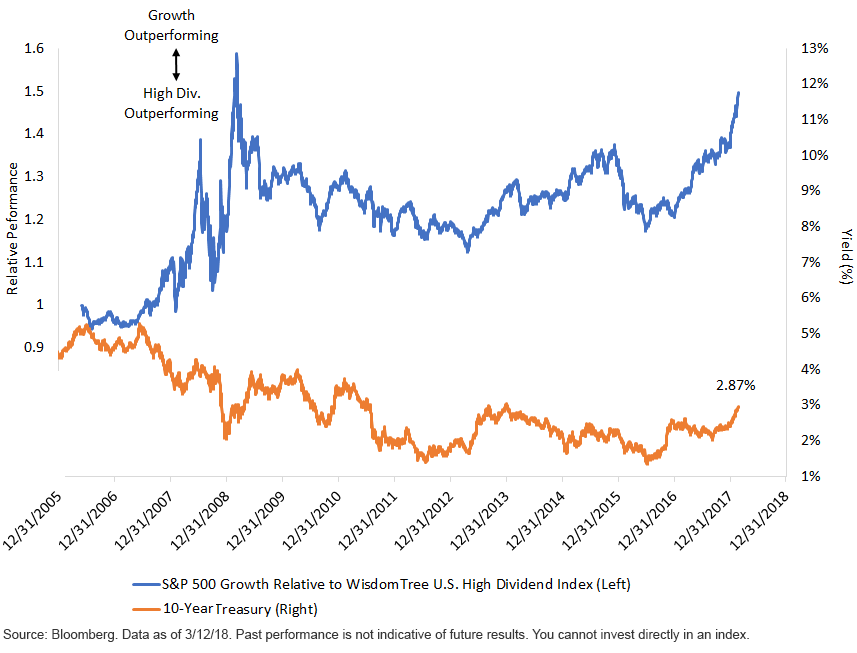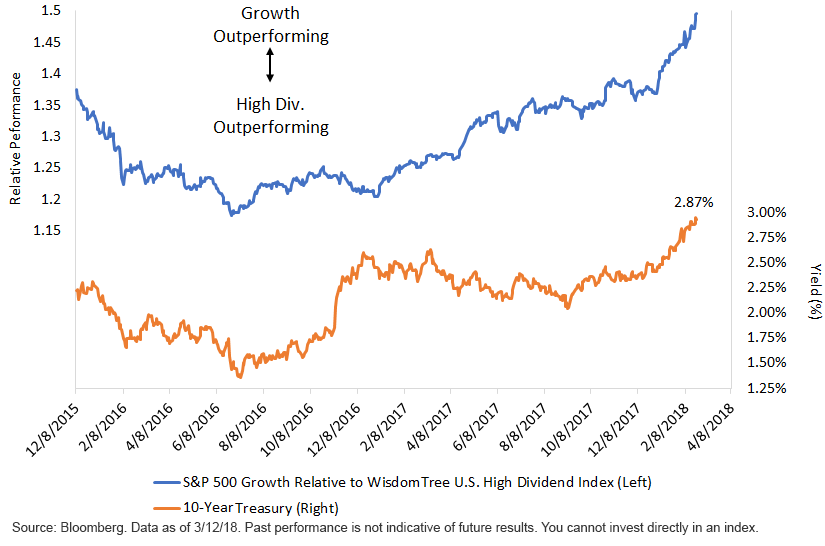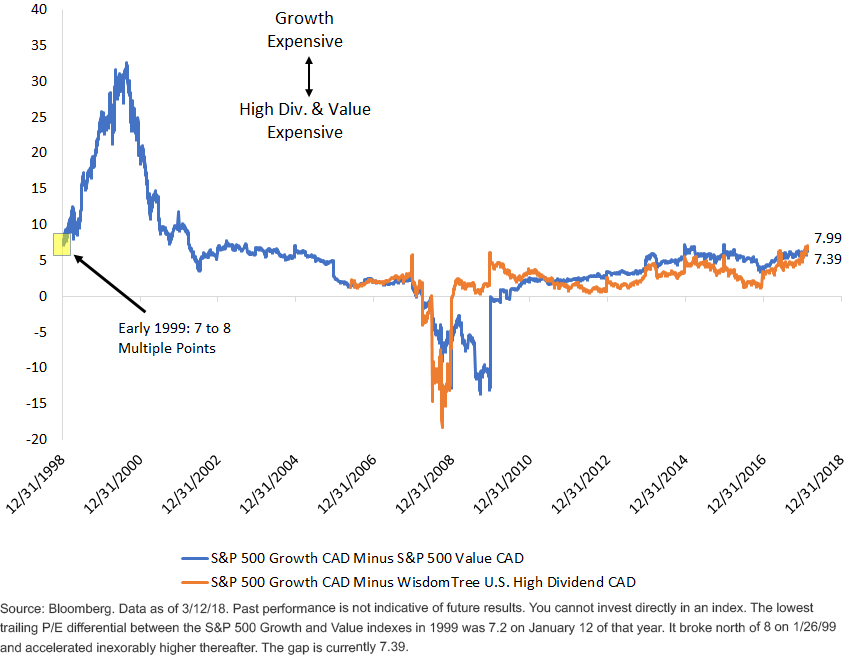High-Dividend Stocks: A Lonely Opportunity?


There is a market “truism” that needs to be set straight. In summary:
“Rising interest rates hinder high dividend equities.”
We’d rephrase it this way:
“Rising rates have been hindering high-dividend equities in the last couple of years, but over any sizable time frame, the causal relationship between rates and equity factors has been cursory at best.”
With that, see figure 1. It shows the S&P 500 Growth Index relative to the WisdomTree U.S. High Dividend Index since the birth of the WisdomTree U.S. High Dividend Fund (DHS) in 2006, along with 10-Year Treasury yields. Growth was outperforming big dividend payers in the years immediately preceding the global financial crisis, and it kept leading during the crisis. Throughout the middle of the decade, bond yields gyrated back and forth, ultimately halving. Yet high-dividend payers struggled, defying today’s popular notion that interest rate directionality is the determining factor of dividend stocks’ relative performance.
Growth stocks’ leadership run ended on March 11, 2009, just days after the stock market bottomed, and high-dividend payers began to outperform in the early years of the economic recovery. Despite improving business conditions, bond yields kept falling until 2012. Those three years were among the few that do appear to confirm the popular “truism.”
Figure 1: Interest Rates Are Not Always the Arbiter of Performance

Then, growth stocks reached their relative bottom on April 19, 2013. Treasury yields were 1.71%. While growth stocks outperformed for years from that point, interest rates yawned, chopping around and ultimately falling to 1.36% on July 8, 2016. Yet the thesis that falling rates help yield-oriented stocks was debunked during that more than three-year spell. From April 19, 2013, to July 8, 2016—when rates were falling by 35 basis points (bps) to that generational low—the S&P 500 Growth Index posted a total return of 53.56% while the WisdomTree U.S. High Dividend Index rose “just” 45.12%, a gap of 844 bps (199 bps annualized).
Finally, the latest stage, which has been characterized by a more than doubling of t-note rates from their July 2016 lows. Growth has continued to outperform, this time with a sharp acceleration higher that has left dividend strategies frustrated (figure 2).
Figure 2: Zooming in on Recent History

We don’t deny that at the current moment, interest rate directionality is a key focus for the market; in fact, we’ve made the case that a reversal of the crowded rising rates consensus could put a bid under DHS. And crowded is an understatement: 38 of 43 economics teams anticipate a rise in 10-Year Treasury yields by the fourth quarter of 2019, with a median target of 3.42%.1 If they are proven wrong—and if the market keeps “caring” about rates in 2018 the way it did in 2016 and 2017—DHS could surprise investors to the upside.
But as we have shown, interest rates have been a tough investment metric over the long term. There must be something more to the dividend payers versus growth stocks decision.
That “something” is relative valuations.
Flagging March 2009
It’s important to take note any time a data point comes back to what it was flashing in 2008 or 2009, the crisis years. S&P 500 Growth’s performance series relative to the WisdomTree U.S. High Dividend Index is back to March 12, 2009, levels, the same week the market put in its lowest close of the generation—and seven days after the end of that growth cycle. From this point, the next three years witnessed the WisdomTree Index outperform by 744 bps per year.
…And 1999
Because DHS and the WisdomTree Index it tracks were created in 2006, figure 3 goes back to the 1990s to capture two decades of growth versus value fundamentals. The S&P 500 Growth Index’s trailing price/earnings ratio is 26.6, about 8 multiple points more than the WisdomTree U.S. High Dividend Index (18.6).2 Similarly, the gap between the S&P 500 Growth and S&P 500 Value indexes is 7.39 multiple points.
Going back to the tech bubble, we saw a gap about this wide in January 1999. We know with hindsight that the growth stock bubble ended a year later at much higher levels. True, the current valuation gap can certainly stretch out like it did then, but backing a repeat of that legendary performance run may not be wise.
If the clock is, in fact, ticking on yesterday’s market leadership, DHS could be primed if dividends come back into style.
Figure 3: S&P 500 Growth Price-to-Sales Minus S&P 500 Value

1Source: Bloomberg, as of 3/12/18.
2Source: Bloomberg, as of 3/12/18.
Important Risks Related to this Article
There are risks associated with investing, including possible loss of principal. Funds focusing their investments on certain sectors increase their vulnerability to any single economic or regulatory development. This may result in greater share price volatility. An investment’s value may decline due to an increase in interest rates. When interest rates fall, income may decline. High-yield or “junk” bonds have lower credit ratings and involve a greater risk to principal. Please read the Fund’s prospectus for specific details regarding the Fund’s risk profile.


